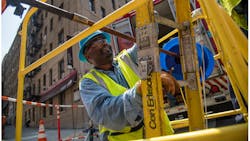Con Edison Invests for Summer 2020 and New York’s Clean Energy Future
Con Edison has invested $1.3 billion in its electric-delivery systems to keep service reliable this summer while continuing to be a leader in adding new technologies to build a clean energy future.
Con Edison is preparing for a typically hot New York summer and one that brings the additional challenge of protecting the public and employees during the coronavirus health emergency.
The company projects summer bills for typical New York City residential customers will be higher this summer due to more people staying home, as well as increased supply charges by power generators. In Westchester County, supply charges may result in slightly lower bills for typical residential customers, depending on usage.
Con Edison does not make a profit on these supply charges and has taken steps to defer some of those costs, as customers struggle financially through the pandemic.
Con Edison is working with customers on payment plans, has suspended turnoffs for non-payment and is waiving new late fees. The company advises that the best way for customers to manage their bills is to conserve on energy. Con Edison has a variety of energy efficiency programs for residential and commercial customers and offers energy-saving tips.
Conservation can be particularly important for residential customers who are spending more time in their homes during the pandemic.
A typical New York City residential customer using 350 kWh per month can expect a 9.5% increase from $99.14 in 2019 to $108.53 per month in the June-to-September period. A typical Westchester residential customer using 500 kWh per month can expect an average decrease of 3% from $121.32 in 2019 to $117.63 per month.
A New York City business customer using 10,800 kWh with a peak demand of 31 kW can expect average monthly summer bills to increase from $2,203.94 in 2019 to $2,320.15 this year.
Investments in Reliability, Clean Energy
While the company has put some work on hold, crews continue with work that ensures summer reliability, emergency work, and other essential projects.
Company crews have installed new cable and transformers on the underground and overhead delivery systems. The upgrades also include network protectors and work at substations. The upgrades cover all regions of the company’s 604-square-mile New York City and Westchester County service area.
In southeast Brooklyn, the crews have replaced 101 sections of underground cable and installed six new switches that isolate faults, reduce outages and allow for faster restoration of customers.
In Westchester County, the company has continued with its $100 million storm fortification program, installing new poles, cable and switches to toughen the overhead system against storms. Storms often follow heat waves when warm, moist air fills the atmosphere.
A project to enhance service in the northeast area of Staten Island replaced 170 spans of overhead conductor, 110 poles and 20 transformers. The project also includes the addition of four smart switches to the grid.
Con Edison is also applying its engineering expertise to take stress off certain equipment in the southwest area of the Bronx, where the demand for power has grown. The company is transferring 6.6 MW of customer demand from one set of underground cables to another set that has capacity to accommodate the load. The project involves installing new cable and 2,000 feet of conduit.
Impact of Health Emergency
Con Edison’s initial projection for peak demand for electricity this summer was 13,220 MW under design weather conditions. But if major restrictions on opening businesses remain in place, demand could peak at 12,000 MW under design conditions. The record is 13,322 MW, which occurred at 5 p.m. on July 19, 2013.
The company expects that more people staying at home due to the pandemic will result in less demand for power in highly commercial areas, such as Midtown Manhattan. But demand in residential areas will increase, particularly on weekdays, as people who are home during the day use their air conditioners and other appliances.
Con Edison will take temporary steps if extreme heat and high energy usage place stress on the grid. Those steps would include sending mobile generators to areas in need.
Con Edison crews working in the streets practice social distancing with each other and the public and use face coverings when the requirements of the work make social distancing not possible. They follow the guidelines of the U.S. Centers for Disease Control and Prevention.
Emerging Battery Technology & Clean Solar
Battery technology has improved rapidly in recent years, providing Con Edison with another tool to help keep service reliable when the demand for power soars on hot summer days.
Con Edison and its partner GI Energy have placed a battery system at a customer property on the North Shore of Staten Island. Under an agreement, Con Edison can discharge power into the grid at times of high demand. The system can provide 1 MW – or 1 million watts, making it a 1-MW/1 MWh system.
Con Edison has a 2-MW/10.6-MWh battery system on company property in Ozone Park, Queens. The system, which the company debuted last year, discharges power into the local grid at times of high demand, taking stress off the electric-delivery equipment upstream of the system.
Con Edison partnered with Enel X to install a 4-MW/16-MWh battery system – the largest in New York City – at the Gateway Center shopping center in Brooklyn’s East New York neighborhood.
Con Edison also encourages customers to consider whether solar energy is right for them. Customers have completed nearly 32,000 solar projects that produce 290 MW of clean, renewable power. That is equal to 381,800 MWh a year, enough to prevent 270,000 tons of carbon emissions, or the equivalent of more than 58,000 cars off the road.
Counting combined heat and power, fuel cells and batteries, Con Edison customers provide more than 500 MW of power via distributed energy resources.
